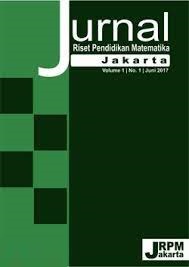Analisis Kemampuan Disposisi Matematis Siswa MAN 1 Sintang Melalui Pendekatan Metaphorical Thinking
DOI:
https://doi.org/10.21009/jrpmj.v4i2.25086Keywords:
Kemampuan Disposisi Matematis, Disposisi MatematisAbstract
This research is motivated by the importance of the ability of mathematical disposition to the material of arithmetic sequences and series in terms of mathematical ability. Where the purpose of learning mathematics contains cognitive aspects seen from problem solving abilities and affective aspects can be seen from mathematical dispositions.This study aims to describe the ability of mathematical disposition for the material of arithmetic sequences and series in terms of the aspect of mathematical ability.The place of implementation in this research is at MAN 1 Sintang with class XI research subjects. The approach used in this study uses a qualitative approach.Data retrieval is carried out by giving a problem-solving ability test question, giving a mathematical disposition questionnaire,and conducted interviews based on the results of the problem-solving ability test questions by each subject. The conclusion from the results of this study is that the students' mathematical dispositions are generally in good criteria
References
Moleong. L. J.2014. Metodologi penelitian Kualitatif.Bandung : Remaja Rosdakarya.
Gunawan, Imam. (2015). Metode Penelitian Kualitatif Teori dan Praktek. Jakarta: Bumi Aksara.
Kosiret, A. ., Indiyah, F. H. ., & Wijayanti, D. A. . (2021). The Use of Generative Learning Model in Improving Students’ Understanding of Mathematical Concepts of Al-Azhar 19 Islamic High School. International Journal of Progressive Mathematics Education, 1(1), 16–26. https://doi.org/10.22236/ijopme.v1i1.6593
Kurniasih, N., Hidayani, F. ., Muchlis, A. ., & Soebagyo, J. (2021). Analisis Kemandirian Belajar Matematika Siswa SMA Kelas XI Selama Pembelajaran Jarak Jauh. International Journal of Progressive Mathematics Education, 1(2), 116–126. https://doi.org/10.22236/ijopme.v1i2.6568
Mahmudi, Ali. (2010). Tinjauan Asosiasi antara Kemampuan Pemecahan Masalah Matematis dan Disposisi Matematis. Makalah disajikan pada seminar nasional pendidikan matematika FMIPA Universitas Negeri Yogyakarta : Yogyakarta, 17 April 2010.
Maesya Firdaus, D., Purwanto, S. E., & Nuriadin, I. (2021). Kontribusi Seft-Efficacy Dan Mathematics Anxiety Terhadap Kemampuan Penalaran Matematika Siswa. International Journal of Progressive Mathematics Education, 1(2), 85–103. https://doi.org/10.22236/ijopme.v1i2.6488
Saida, . A. ., Ikram, M., & Salwah. (2021). Analysis of Students’ Creative Thinking in Solving Cuboid Problems. International Journal of Progressive Mathematics Education, 1(2), 104–116. https://doi.org/10.22236/ijopme.v1i2.7307
Sulistyorini, E. E., Laili, N. ., & Rahmadiana, S. . (2021). Profil Pemahaman Siswa Pada Materi Peluang Berdasarkan Tingkat Kemampuan Matematis Melalui Pembelajaran Jarak Jauh (PJJ). International Journal of Progressive Mathematics Education, 1(2), 143–160. https://doi.org/10.22236/ijopme.v1i2.6569
Sugiono. (2015). Metode Penelitian Kuantitatif, Kualitatif, dan R&D. Bandung: Alfabeta.




